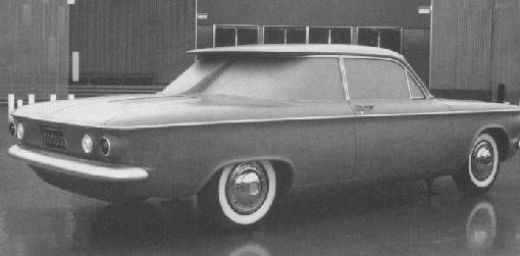The gen1 Corvair coupe’s roof line has always been a bit polarizing. Love it, hate it; or both, in my case. Especially compared to the ’65’s graceful solution, the 1960 – 1964 coupe just came up a bit short, literally. More like a business coupe. And it sure accentuated that long tail. But getting to the final design involved some alternatives, of which this one is the most interesting. It’s the only picture I’ve ever seen where the flying roof was tried out on a coupe. And with a flying buttress up the middle of it. What’s the verdict? Before you vote, here’s some other rejected designs too:
The flying roof clay was from 1958, by which time the designs were being finalized. Now this one here is from 1957, and we can see that the whole rear end for the coupe was having some imagination applied. Plus it looks like a two-seater, or maybe a 2+2 at best. A bit too Harley Earl for my taste. He was still there for the Corvair’s early design stage, but the final car was shepherded by Bill Mitchel. That would explain how it came out so clean.
Now this one is also dated 1958, and shows the direction taken and being quite close to the final design.
The Corvair initially came only in the four-door sedan, but early in 1960 at the NY Auto Show, Chevrolet displayed the Corvair Super Monza, with those side strakes, a sunroof, and bucket seats. It generated lots of interest, and the Monza was quickly put into production, along with the lower trim coupes. The Monza was an instant hit, although only some 11k could be built for the 1960 MY. In 1961, it was the best selling model, and some 110k Monza coupes were snapped up.
The Monza coupe also has different rear wheel cutouts, and does come across quite different from the sedan. And preferrably without whitewalls, and some nice period mag wheels.
Pininfarina’s 1963 take on the Corvair coupe was decidedly more flowing, and the coupe’s roof line predicted the 1965’s to a considerable extent.
That’s a story for another (Corvair) day.




























All I can say is Holy S***! That flying buttress is the strangest idea I’ve ever seen. Where you find this stuff? What a site.
That first one is like a more modern version of Studebaker’s 1947 Starlight coupe. The flying butress is just wierd.
Are the side strakes from the Super Monza the ones that ended up on the 61 Tempest?
It’s ironic that GM removed the likely functional side intake from the Corvair Monza while a fake one later became a Mustang trademark.
The 1967 Mustang has the side “intake” from the first 1958 photo, while the second 1958 photo predicted the 1965/66 style Mustang side “intake”
The Corvair in the second 1958 photo looks like it has a fake grille in front (plus a retracting sunroof!)
The second picture down, the 1957 clay, would make more sense if that was supposed to be the front of the car, not the back!
I always wondered why, given the European nature of the Corvair, that the Super Monza wasn’t carried into production as is, with the Sunroof. Perhaps too expensive/too competitive with the pending convertible? I guess that’s my main wish of all American cars, even today. While Imports embraced Sunroofs long ago, there’s many American Cars beyond Studebakers that would be even greater with a lil more sunshine.
Side gills would have looked good on the 65 especially if they functioned Best one so far that 65 coupe but I like the Pininfarina take on it too very nice
My first reaction was that the second picture looks like a shrunken flower car (for those of you interested in “professional cars”).
As the owner of a ’64 coupe, I will say that it’s my favorite closed Corvair from a styling standpoint. However, it is strictly a “club coupe” and makes no pretensions of being a two-door sedan. The rear seat is definitely a penalty box, and you also lose the behind-the-seat storage cubby that the sedans have. Early Corvair literature keeps touting that storage area and doesn’t really make clear that the coupes don’t have it. The rear seat folds down, which does give you something like a business coupe.
I see a lot of Ford Consul Capri in the second photo